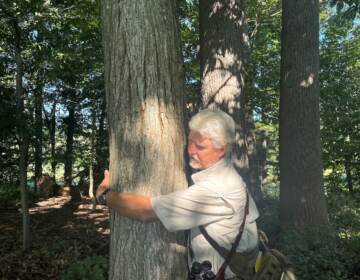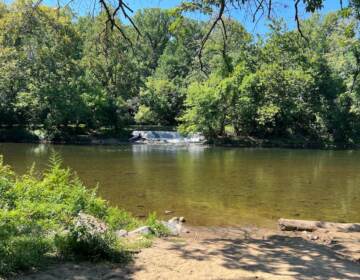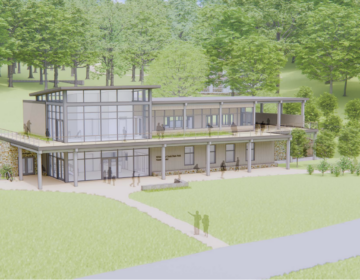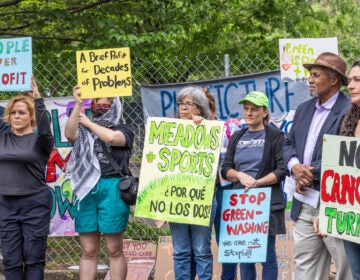Delaware hikers take trek to ‘middle of nowhere’ for glimpse of rare adult American chestnut
This American chestnut was discovered by chance when a hunter recognized it. The Delaware Nature Society led its first expedition to the rare tree.
Listen 3:58
Courtney Streett (right foreground) gazes up at the American chestnut tree in Delaware with other hikers as guide Joe Sebastiani (gray baseball cap) gives a tutorial. (Cris Barrish/WHYY)
Octogenarian and botanist Anne Nielsen couldn’t pass up a rare chance to see an adult American chestnut tree.
The diminutive Nielsen, bristling with energy and curiosity at the age of 87, was visiting her friend Diane Kesler in Kennett Square, Pa., when they learned about a guided tour to the only such tree in Delaware.
So, a little hunched over and aided by a collapsible trekking pole, Nielsen joined Kesler, eight years her junior, and about 20 other eager souls last week on a nearly 90-minute hike to the cherished tree at Coverdale Farm Preserve in Centreville.
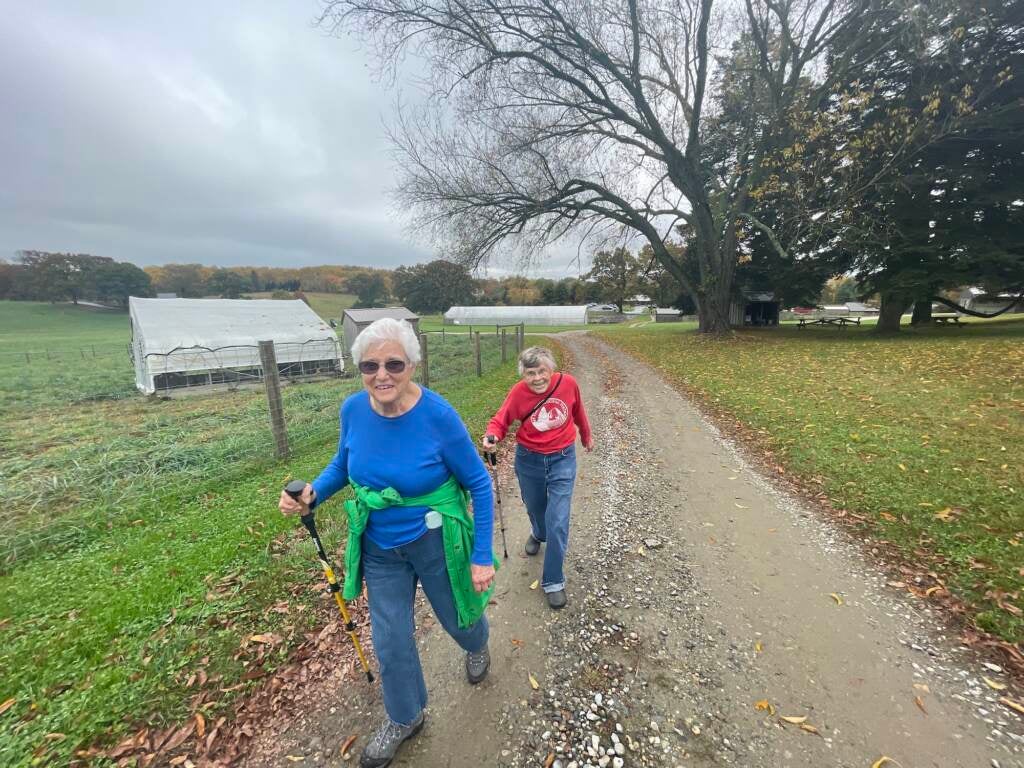
The bucolic 377-acre site deep in the rolling hills of rural northern New Castle County is where an eagle-eyed hunter stumbled upon and recognized an American chestnut that somehow escaped the blight which eviscerated the species in the early 1900s.
There are still billions of American chestnuts but the vast majority are less than one inch in diameter and they die and resprout in a repetitive cycle.
“They are these tiny diseased things,’’ says Sara Fitzsimmons of the American Chestnut Foundation.
But the Delaware tree, estimated to be about 60 years old, is about 65 feet high with an 18-inch diameter. Fitzsimmons says it’s larger than 95% of the roughly 500 chestnuts her group has documented. The largest in the group’s database are in Maine. One is 112 feet tall; another is 40 inches in diameter.
“I’m always interested in seeing an American chestnut tree,’’ Nielsen gushed at the outset of the hike. “Most of the ones I have seen in the past have been hybrids, because the native American Chestnut so far has not been resistant to the chestnut blight.”
Her friend Kesler, who recently moved to Chester County, said she once lived on land in Virginia that had blighted, stunted American chestnuts. So she wanted to see a full-grown one in person.
Courtney Streett, a Native American and member of the Nanticoke tribe in Sussex County, couldn’t wait for her glimpse.
“The American chestnut had a significant role for indigenous communities here in the U.S.,’’ Streett said. “To have a tree as mature as this one is incredibly unusual and to have the opportunity to see it is really special.”
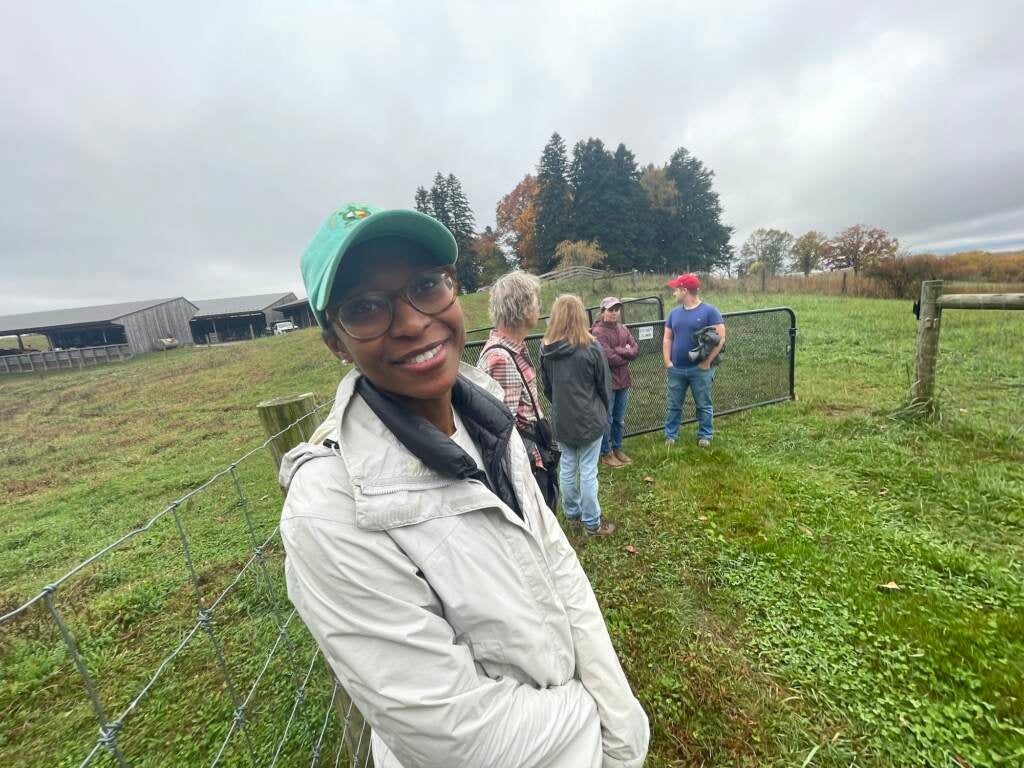
‘No primeval forest left in Delaware, but this is pretty old’
Two guides from the Delaware Nature Society escorted the hikers in separate groups on a journey that was mostly a picturesque stroll through wide paths and over a wooden bridge that crossed a trickling stream.
At the end, however, it was a steep rugged trudge through weeds and stickers, and over fallen twigs, branches and tree trunks.
“It’s kind of in the middle of nowhere,” guide Joe Sebastiani warned with good cheer.
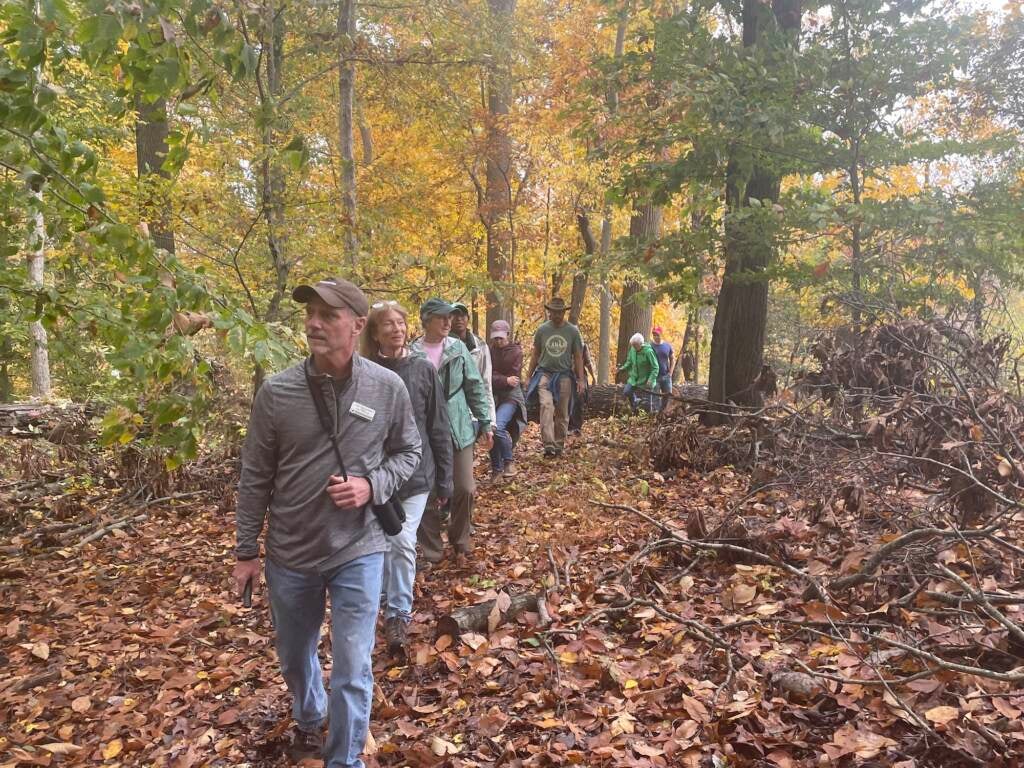
The tour was the first that the nature society, which owns the preserve, had promoted as a chance to see the American chestnut, and many hikers said they leaped at the chance after seeing or hearing WHYY’s story in September.
The land isn’t open to the public except for special tours, so on this warm late October day the visitors were treated to not only a sighting of the special chestnut, but also to a colorful afternoon through an old-growth forest that literally sparkled with yellows, browns, reds, and oranges.
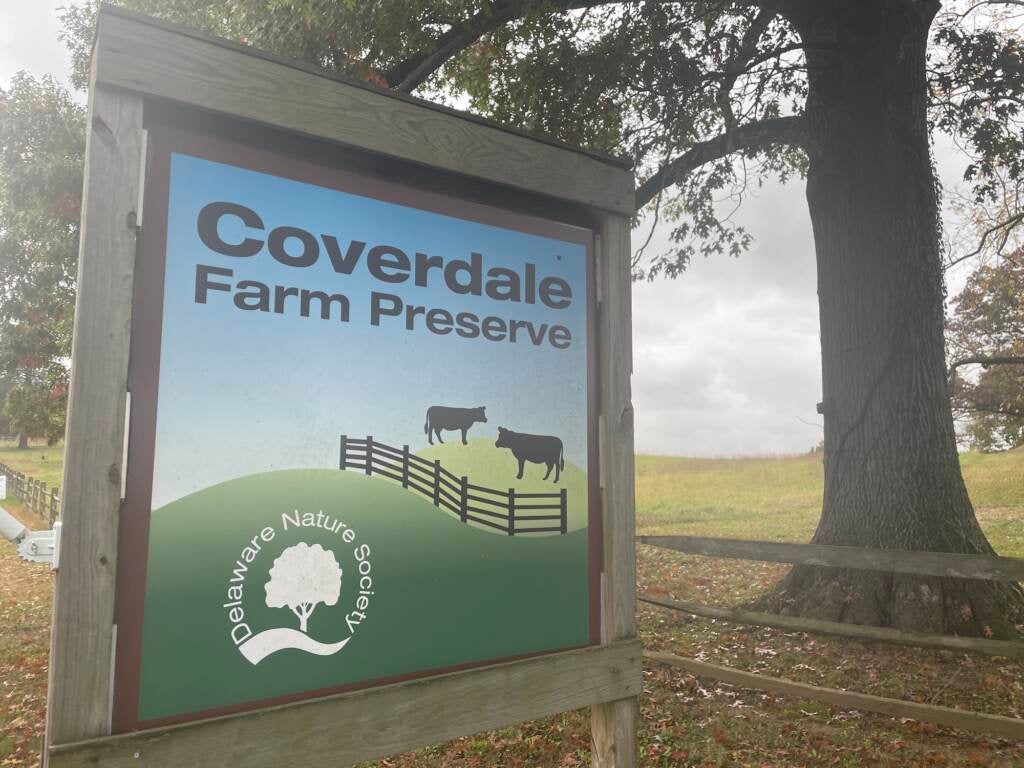
Sebastiani, who led the group, took time to identify the variety of trees — such as sugar maple, American hazelnut, Eastern red cedar, green and white ash, beech, black oak, and sycamore — plus several towering tulips and a majestic state champion blackgum tree.
“Old growth means that it’s probably been about 150 years since the last time this was cut,’’ Sebastiani explained. “And around here all the forests at one point or another were cut. There is no primeval forest left in Delaware, but this is pretty old.”
The grandeur of some trees, as wide as three feet in diameter and up to 125 feet tall, was testament to Sebastiani’s claim.
Sebastiani also shared his encyclopedic knowledge of the preserve.
He’d stop and point in the distance, once to a small falcon he identified as an American kestrel, another time to a trio of deer bouncing along a far-off meadow.
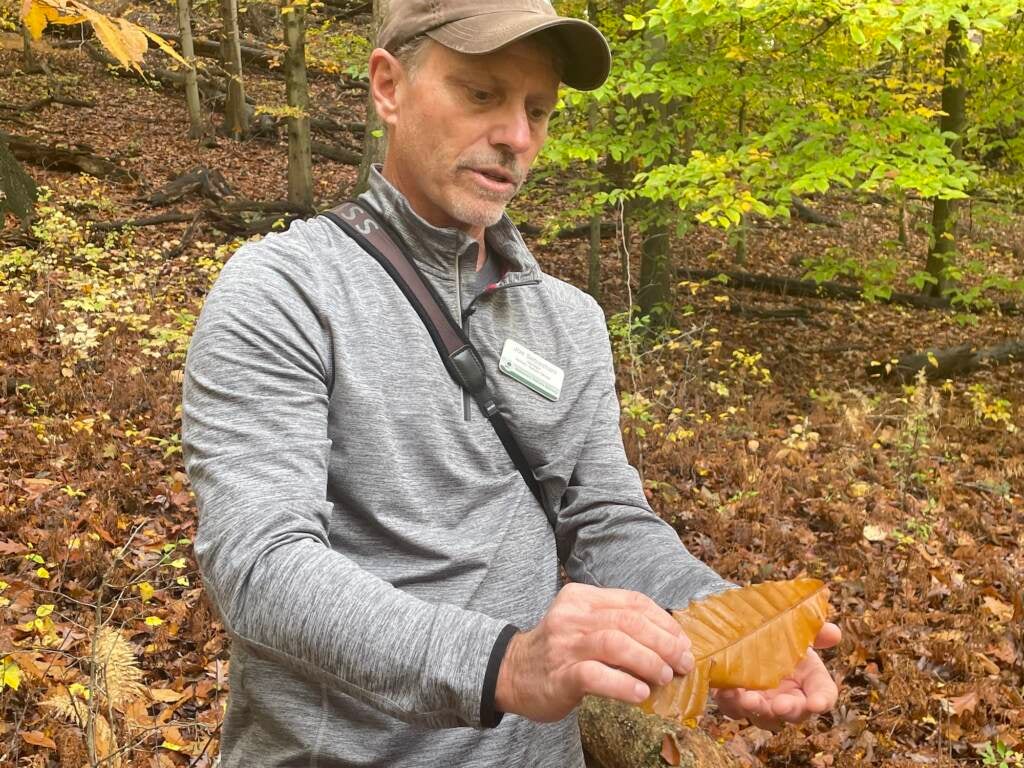
He explained how an insect is also destroying ash trees, much like the fungus that basically wiped out the American chestnut.
He stopped at a set of rocks created more than a half-century ago as a reflective space for Crawford Greenewalt, a former DuPont CEO who once owned the land.
The group even stopped to soak in the experience as a cascade of leaves fell from the trees to the earth with the pitter-patter of a soft rain.
Then Sebastiani silenced everyone for a few minutes as they crept up an incline where owls congregate. He found some droppings but nobody spotted one of the elusive creatures.
And when he pointed out a persimmon tree with a piece of fruit dangling from a limb, he urged Sheila Vincent to take a bite.
“It’s delicious,’’ Vincent proclaimed.
“Is it acerbic?” one hiker asked.
Vincent said it was a little dry but overall, “it’s very sweet.”
‘We’ll kind of bushwhack our way up that way’
After about an hour, the relaxing waltz was over. Sebastiani pointed up a slope.
“All right. We’re going to go off trail,’’ he announced. “We’ll kind of bushwhack our way up that way a little bit up on the hillside, that sort of dry knoll up there. And we’ll go right up to the chestnut tree through that mature woods.”
Streett soon realized what he meant.
“You lost your path,’’ someone suggested as she struggled upward.
Street took the gentle rib in stride, “He said ‘follow me,’ and I was like, ‘Oh that’s the bite,’’’ she said with a chuckle.
As the group made its deliberate quarter-mile ascent, and Sebastiani exclaimed how “spectacular’’ many of the trees on the route are, Nielsen suddenly called from the back of the pack.
Everyone looked down. The eldest in the group had stopped.
“Are you going to come back this way?’’ she inquired.
“We are,” Sebastiani replied.
“I’m done, I’ll see ya,’’ Nielsen blurted, then settled onto a huge felled tree trunk.
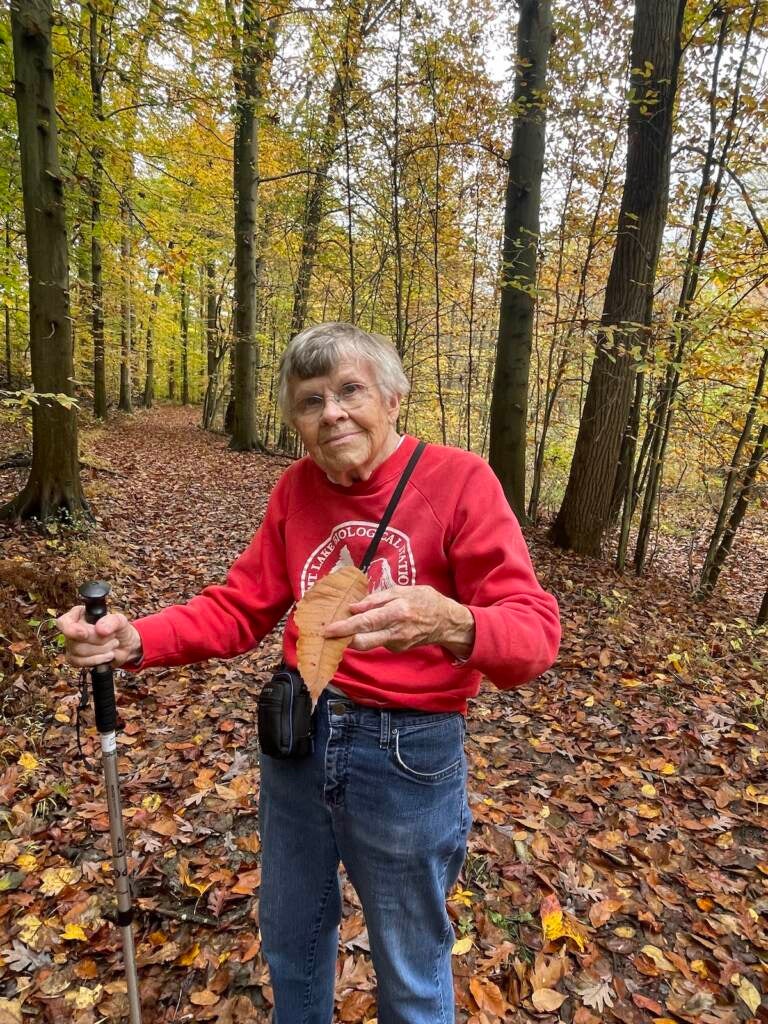
Members of the group agreed to get her pictures and describe the experience.
After five more minutes of mushing, Sebastiani told those closest to him, “We’re getting close, About 50 feet.’’
‘This is a pretty big tree. You’re right. Wonderful.’
The state’s only documented American chestnut stands in a grove with thicker and taller tulips and oaks, but draws instant oohs and aahs.
“It’s magnificent. It’s beautiful,’’ marveled Streett. “The bark is a much lighter color than the other trees in the forest.”
And there’s a surprise, too.
Next to the adult, standing about 4 feet tall, rooted in a plastic pot, is an American chestnut sapling. Sebastiani explained that it was created a year ago by breeding pollen of the Delaware tree with one in Pennsylvania. Sebastiani says the hope is to create more and then begin planting them.
The hikers beamed as they gazed at both the rugged adult tree and the baby, at the distinctive jagged leaves and the spiky husks that once held nuts.
“You can see why this one’s pretty special,’’ Sebastiani said. “And you ask yourself, well, why is this alive? Why didn’t it succumb to the blight?”
He speculates that it “might have some natural defense’’ against the fungus, or perhaps that a hypovirus has attacked and neutered the killer fungus.
“But nobody really knows,’’ he admitted.
Sebastiani also explained that the big tree does have blight, and points to cracks in the bark where the fungus has penetrated.
“See where it’s swollen and orange right there in the cracks?’’ he asked. “That is the blight, sort of sending out the sporeheads to release spores.”
He pointed skyward, where a limb looks withered. “You can see this limb straight up here that’s really swollen,’’ he said. “That limb was sort of killed off by the blight.”
About 10 minutes and hundreds of cell phone snapshots later, the group descends, to find Nielsen sitting patiently on the felled log. She sees Sebastiani carrying the sapling.
“Oh, you brought a tree back for me,’’ she exclaims. “Ha ha ha.”
“We’re going to be planting about six or seven of these here,’’ he tells her.
“OK,’’ she replies. “Great, great.”
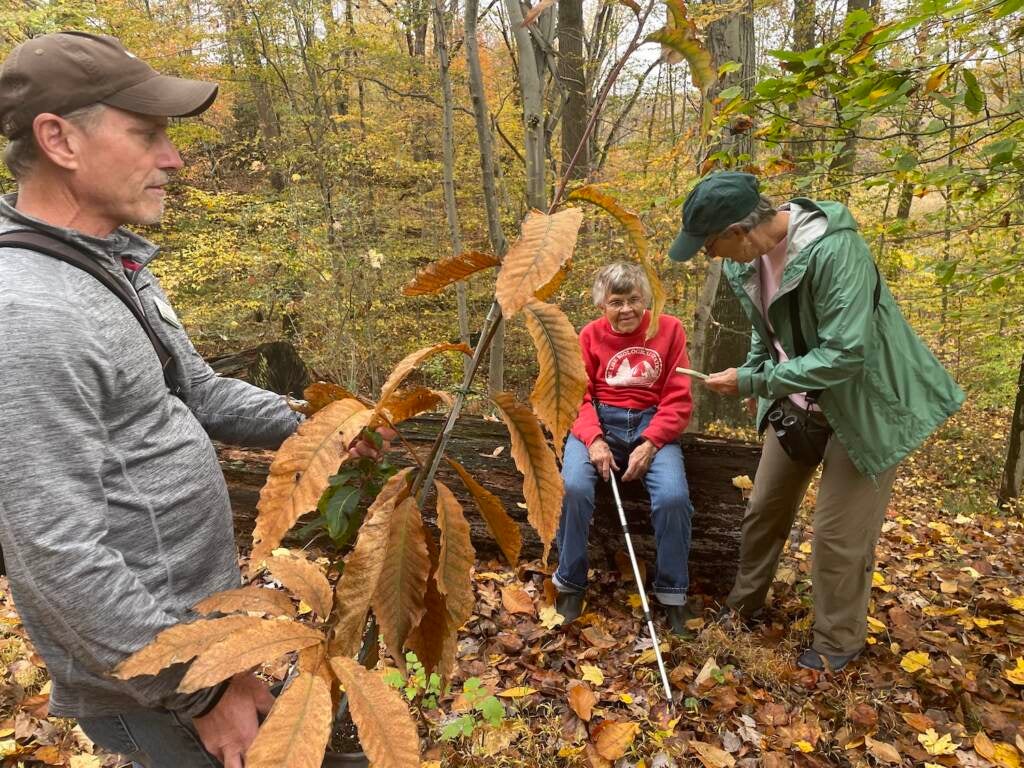
One woman shows Nielsen an array of photos.
“Wow, this is a pretty big tree. You’re right,’’ she says, looking at Sebastiani, “Wonderful.”
As for having to call it quits before the final push, Nielsen shrugged it off.
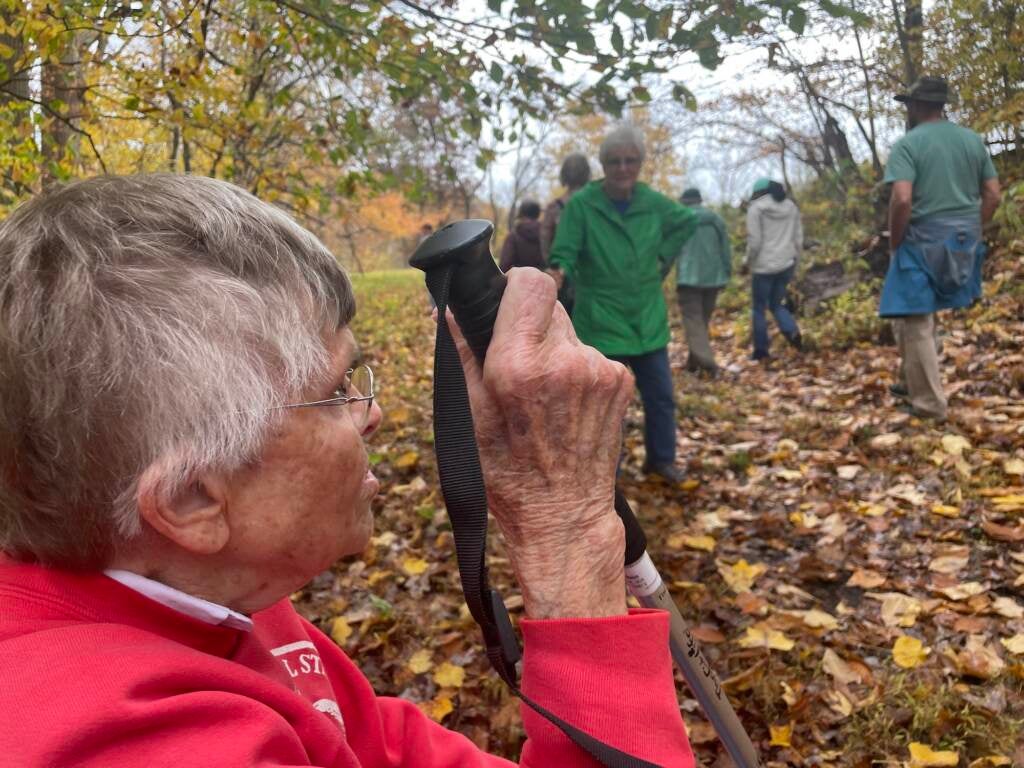
“Ah, I’m old,’’ she says. “My knees are just giving out on me. And we’ve got to go back. I don’t want to be carried. I was just saving something for the trip back.”
“I’m delighted that it’s there. And I’m looking forward to what happens from here,” she added.
Then, satisfied with the fruits of her quest, Anne Nielsen stood up, tapped her walking stick on the damp earth, and started the long walk back through the forest.

Get daily updates from WHYY News!
WHYY is your source for fact-based, in-depth journalism and information. As a nonprofit organization, we rely on financial support from readers like you. Please give today.



